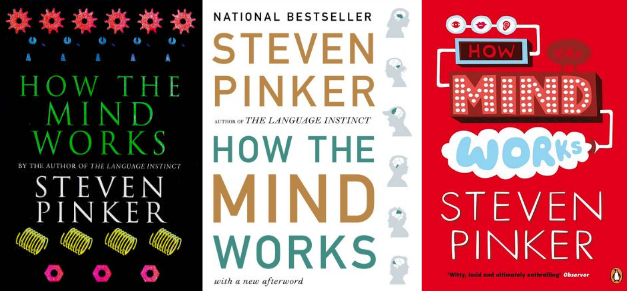

This book completely alters the way one thinks of thinking. – The New York Times
The humour, breadth, and clarity of thought make this work essential reading for anyone curious about the human mind. – The Observer
Let’s get this out of the way: How the Mind Works does not do what it says on the box – id est, it doesn’t answer the question of how the mind works. (In fact, the book starts with Pinker stating we don’t know how the mind works and ends by saying perhaps we may never know how the mind works.) What the book most certainlydoes do however is make a dashed good attempt at coming to grips with how the mind evolved, how it allows us to see, think, feel, interact, enjoy the arts, and ponder the mysteries of life. And Pinker does so with a gift that’s quite rare for science writers: a brilliant sense of wit and humour.
For those who don’t know Steven Pinker, he’s one the world’s leading cognitive neuroscientists. The two central premises on which Pinker’s book is based are evolution and the computational theory of the mind: the notion that the brain is like a computer that follows its own algorithms, modules, schemas, and neural rules arising from the pressures of natural selection over millennia. Once we figure out these instructions we will be well on our way to understanding the human brain and how the mind works. As one reviewer puts it, the book is like ‘Babbage and Turing meet Dawkins and Darwin’
What the book does really well is examine mundane everyday human acts through Confucius’ dictum: “A common man marvels at uncommon things; a wise man marvels at the commonplace.” For instance, after a long expiation on programming robots he makes the point that ‘for all its moonstruck madness, love is no bug or crash or malfunction. The mind is never so wonderfully concentrated as when it turns to love.’ He marvels at the colossal amount of programming it would take for us to duplicate in a robot the peculiar logic of attraction, infatuation, courtship, coyness, surrender, commitment, malaise, philandering, jealousy, desertion, and heartbreak.
In this book we see Pinker’s first adumbrations of the idea that free will is an illusion. (An idea brought to the fore and developed at length in Michael Gazaniga’s Who’s in Charge and Sam Harris’ Free Will.) Pinker makes the point that free will is an idealisation of human beings that makes the game of ethics playable. Just as Euclidian geometry requires idealisations like infinite straight lines and perfect circles for its deductions to be useful, so too does our justice and ethical systems need idealisations like sane, rational, sentient agent for whom free will is taken as a given.
Oliver Sacks once famously said, ‘We see with our eyes. But we also see with our brain.’ For me the most fascinating sections of the book deal with how vision works in the brain. Pinker starts off by quoting Daniel Dennet’s denunciation of the homunculus fallacy. He then goes on to explain the evolution of colour, stereoscopic and cyclopean vision, how the visual system ‘assumes’ that matter is cohesive, surfaces are uniformly coloured, and objects don’t line up in confusing arrangements. Most fascinating of all is his explanation of how auto-stereograms work and how they trick the eye and the brain into seeing 3-dimensional illusions on otherwise flat 2-dimensional paper.
Along the way, Pinker addresses the vexatious question of whether nature or nurture is responsible for individual personality and how it arises in the brain. (We now know that epigenetics—heritable changes in gene expression caused by external factors—also goes a long way in explaining not just personality traits but also why some people are obese and others aren’t) Pinker uses numerous case studies based on identical twins separated at birth to discover the causes of variations in personality.
The book ends on an absolutely riveting note by positing an evolutionary explanation for our appreciation of art, music, philosophy, and the experience of the sublime.
The lay reader be warned, for all its wit and clarity and humour, this book isn’t ‘Diet Science’ or ‘Philosophy Lite’ – it’s serious, heavy duty stuff definitely not to be read to kill a vacant hour or pass the monotony of an idle moment. However, anyone really interested in the mysteries of the mind, from mental images to romantic love, from why we laugh and how optical illusions work to discussions on art, music, literature, humour, religion, and philosophy will absolutely love this book.